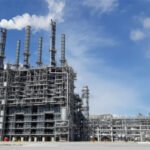(Courtesy of Yonhap)
Tesla Inc. is in talks with SK Hynix Inc. at the US electric vehicle giant’s request to order up to 1 trillion won ($725 million) worth of enterprise solid-state drives (eSSDs), a core component of AI chips alongside high-bandwidth memory (HBM) chips, confirmed sources in the chip industry on Thursday.
Enterprise SSD, or eSSD, is a data storage device for servers, and NAND flash is the main component of an eSSD, which also includes dynamic random access memory (DRAM) chips and a controller.
It is smaller than the hard disk drive (HDD), which stores data in magnetic disks, and consumes less power despite its high speed.
According to Solidigm, SK Hynix’s NAND flash memory developing subsidiary, eSSD can save electricity costs to one-fifth for five years compared to HDDs, with a 46% reduction in total cost.
With explosive demand growth for AI chips, the demand for eSSDs, capable of processing massive data at fast paces, is also skyrocketing, becoming a core part of AI chips alongside HBM chips.
Solidigm has developed the industry’s highest capacity 60 terabytes (TB) eSSDs, which have been already supplied to many big tech companies.
Solidigm’s ssd for data centers (Courtesy of Solidigm)
FOR DOJO
Tesla has vowed to invest $10 billion every year in building its AI supercomputer, called Dojo, and it needs fast and large capacity drives, like eSSDs, to improve the efficiency of its AI supercomputer system.
Dojo is Tesla’s custom-built supercomputer designed to train its “Full Self-Driving” neural networks, which will be implemented in its electric vehicles, robotaxis and humanoid robots for autonomous operation.
For its fast AI advancement, Dojo needs high-performing memory devices such as eSSDs that are capable of storing, reading and writing massive data.
The demand for eSSDs is soaring from not only Tesla but also other big tech companies such as Microsoft Corp., Amazon.com Inc. and Meta Platforms Inc. that are actively incorporating AI inference servers designed to run trained AI models to perform inference tasks in real time.
The eSSD is a must to have in AI inference servers for fast data extracting, reading and writing.
(Screenshot captured from SK Hynix website)
BIGGER ESSD MARKET AND RELATED INVESTMENT
According to global tech market intelligence TrendForce, global eSSD sales nearly doubled to $6.9 billion in the third quarter ended in September from $3.8 billion in the first quarter. It forecasts the global eSSD market will grow to about $20 billion in 2027.
Riding on the eSSD boom, Samsung Electronics Co., SK Hynix’s cross-town rival, said in August it will unveil the industry’s highest-capacity 128TB eSSD, BM1743, in November to compete with eSSD market leader Solidigm.
SK Hynix and Solidigm with the world’s leading quad-level cells (QLC) NAND SSD technology are currently developing 122TB eSSDs with a goal to pass its customers’ tests for use in the first half of next year.
QLC refers to NAND flash with each storage cell capable of recording 4 bits, and it allows more data to be stored in the same space compared to other NAND flash memories thanks to its higher data density.
It is already used in SK Hynix’s 60TB eSSDs.
The Korean memory giant said on Thursday that its eSSD sales accounted for more than 60% of its total NAND sales in the third quarter after surging 20% from the previous quarter and 430% from a year ago.
SK Hynix will beef up investment in AI memory chips such as HBM chips and eSSDs to meet their anticipated high demand next year, said Kim Woo-hyun, the company’s chief financial officer.
SK Hynix shrugged off the industry’s concerns about the looming “memory chip winter” after reporting its historic high quarterly sales and operating profit in the third quarter on the same day and anticipated a supply shortage of AI memory chips next year due to insatiable demand.
SK Hynix shares ended up 1.1% at 198,200 won on Thursday, outperforming the country’s benchmark Kospi index falling 0.7%.
By Jeong-Soo Hwang, Chae-Yeon Kim and Eui-Myung Park
hjs@hankyung.com
Sookyung Seo edited this article.















